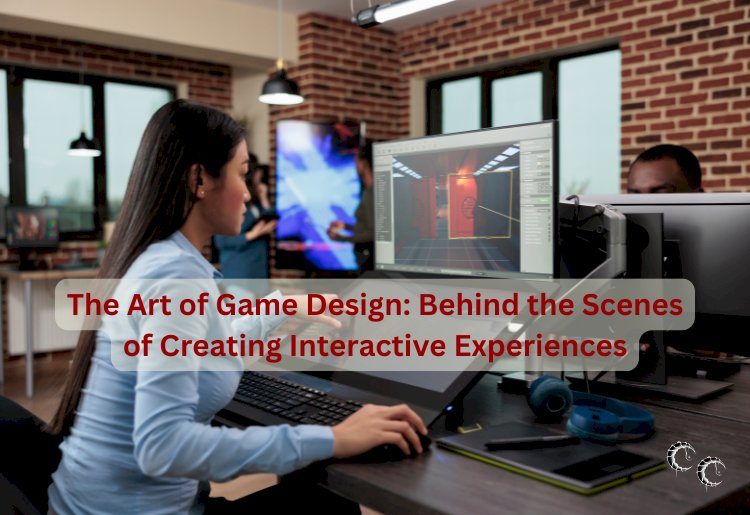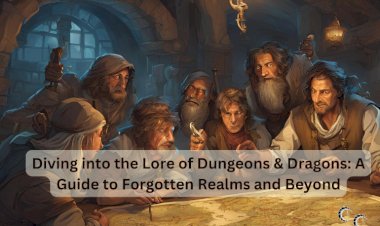The Art of Game Design: Behind the Scenes of Creating Interactive Experiences

In the world of entertainment, few industries have evolved as rapidly and as creatively as video game design. From pixelated characters in the 1980s to lifelike virtual worlds today, video games have become more immersive, intricate, and interactive than ever before. Behind every game, from indie creations to multi-million dollar blockbusters, is an intricate web of creativity, innovation, and technical expertise. Game design is not just about coding and graphics—it's about crafting experiences, telling stories, and engaging players in ways that other forms of media can't.
In this article, we'll take you behind the scenes of game design, exploring the key elements that go into creating interactive experiences that captivate players. From initial concept to finished product, game design is a blend of art, science, and storytelling that transforms ideas into interactive worlds.
What is Game Design?
At its core, game design is the process of creating the rules, mechanics, and systems that govern a game. However, this definition barely scratches the surface. Game design is about crafting an experience that resonates emotionally with players, challenging them, entertaining them, and making them feel immersed in a virtual world. It’s a multidisciplinary process that involves creativity, logic, technology, and psychology.
The role of the game designer can vary depending on the size of the project and the specific type of game being made. In larger studios, game designers might specialize in specific areas like level design, systems design, or narrative design. In smaller teams, designers often wear many hats, overseeing everything from gameplay mechanics to user interface (UI) design.
The Phases of Game Design
Creating a game is a long and complex process, involving multiple stages that each require different skill sets and considerations. The typical phases of game design can be broken down into the following stages:
-
Conceptualization and Pre-production: This is where the game begins to take shape. Game designers and developers collaborate to come up with an initial concept, which includes the genre, setting, storyline, gameplay mechanics, and overall vision for the game. It’s also during this stage that the game’s core ideas are tested and refined. Designers will brainstorm features, draft early prototypes, and test basic gameplay loops.
In pre-production, the team may develop a game design document (GDD), which serves as a blueprint for the entire project. This document outlines the game’s mechanics, narrative, art style, level design, and more. It’s essentially the game’s roadmap, and it helps guide development through the later stages.
-
Design and Development: Once the initial concept has been approved, it’s time to start building the game. During the design phase, developers begin creating the game’s systems and mechanics, as well as fleshing out the world. For instance, in a role-playing game (RPG), this might involve developing combat mechanics, inventory systems, and character progression.
Artists will begin creating the visual assets needed for the game, from environments to character models and animations. The sound design team will create sound effects, music, and voice acting to bring the world to life. Programmers write the code that ensures the game’s mechanics and visuals function smoothly. Designers will also work on level layouts, ensuring that players experience a mix of challenge, progression, and engagement throughout their journey.
This phase is a highly iterative process—testing, feedback, and refinement are crucial. Designers need to ensure that the gameplay feels balanced and rewarding, and they often adjust mechanics based on playtesting results. Each level or stage is carefully crafted to provide a new challenge or reward, ensuring that players are constantly engaged.
-
Polishing and Refinement: The polishing phase is where developers refine the game to ensure a smooth experience. This includes bug testing, optimizing performance, and fine-tuning mechanics. During this phase, designers often take a step back and focus on small details that enhance the player’s experience, like animations, sound effects, or even hidden Easter eggs that encourage exploration.
Playtesting is a major part of this phase, as it helps identify areas where players may be confused, frustrated, or bored. Based on player feedback, adjustments are made to improve pacing, difficulty, and overall enjoyment.
-
Launch and Post-release: After months or even years of development, the game is finally ready for launch. The final product is packaged, distributed, and marketed to the public. However, the work isn’t over yet—many games today continue to evolve after launch through downloadable content (DLC), updates, and expansions. Game designers work closely with the community to address feedback and make improvements over time.
Post-release support can involve fixing bugs, adding new content, or balancing the game to ensure players continue to enjoy the experience long after the initial release.
Key Elements of Game Design
Several key elements come together to create an engaging and interactive game experience. Let’s take a closer look at some of the most important aspects:
-
Gameplay Mechanics: Gameplay mechanics are the rules and systems that govern how a player interacts with the game. This includes everything from movement controls, combat systems, and inventory management to puzzles, character progression, and resource management. Mechanics are what make a game fun, challenging, and rewarding.
A good game mechanic is intuitive, engaging, and well-balanced. Whether it’s a simple jump mechanic in a platformer or a complex combat system in an RPG, gameplay mechanics are the foundation of any game. Designers must continually test and tweak these mechanics to make sure they provide an enjoyable experience without becoming frustrating or repetitive.
-
Story and Narrative Design: A great story can elevate a game from a fun diversion to an emotionally impactful experience. Narrative design involves creating the world, characters, dialogue, and plot that guide the player through the game. In many cases, the narrative is what drives the player’s motivation to continue playing.
Narrative design isn’t just about writing dialogue—it’s about creating an immersive world that feels real, with characters that players care about. Good game writers collaborate with designers, artists, and directors to ensure the story integrates seamlessly with the gameplay. Whether it’s a branching narrative in an open-world game or a linear plot in a platformer, storytelling is a crucial part of the overall design.
-
Level Design: Level design is the process of creating the environments and spaces where the player interacts with the game. This involves designing areas where players will navigate, solve puzzles, engage in combat, and progress through the game.
A well-designed level should provide a sense of challenge, progression, and discovery. The layout should encourage exploration and reward the player for overcoming obstacles. Level designers often create the structure of the game’s worlds, ensuring that the environment enhances the player’s experience and fits within the broader context of the game.
-
Art and Visual Design: The visual elements of a game—the graphics, animation, and art style—play a huge role in immersing the player in the game world. Whether it’s the stunning realism of a AAA title or the charming simplicity of an indie game, art design helps define the mood and atmosphere of the game.
Art design involves everything from character models and environments to textures, lighting, and color palettes. It’s a highly collaborative process, with designers, animators, and visual artists all working together to create a cohesive and visually appealing experience.
-
Sound and Music: Music and sound design help create an emotional connection to the game. The right soundtrack can enhance the mood of a scene, while sound effects provide feedback to the player, letting them know how their actions impact the game world.
Sound designers often collaborate closely with game developers to ensure that every sound effect and musical score fits within the world of the game. Music can also be used strategically to build tension or reward players, while sound effects provide crucial information—like the sound of footsteps or a distant explosion—that guides the player through the experience.
The Future of Game Design
As technology continues to advance, so too does the world of game design. Virtual reality (VR), augmented reality (AR), and artificial intelligence (AI) are all pushing the boundaries of interactive experiences. In the future, players may not just engage with games on a screen—they could step inside the game world, interacting with it in ways that feel incredibly real.
Game designers are already experimenting with new tools and techniques to create more immersive, personalized experiences. Whether it’s using AI to generate dynamic stories or VR to create fully immersive environments, the future of game design is an exciting one, full of new possibilities and creative potential.
Conclusion: The Craft of Creating Interactive Worlds
Game design is more than just making a fun game—it’s about creating an experience that resonates with players and keeps them coming back for more. From the gameplay mechanics to the narrative, art, and sound design, every element of a game must come together seamlessly to create an immersive, interactive experience.
Behind every great game is a team of designers, artists, writers, and developers working together to bring a vision to life. The next time you pick up a controller or boot up your favorite game, take a moment to appreciate the artistry and effort that goes into creating these interactive worlds.






























